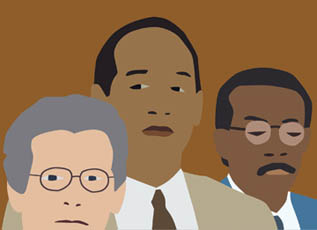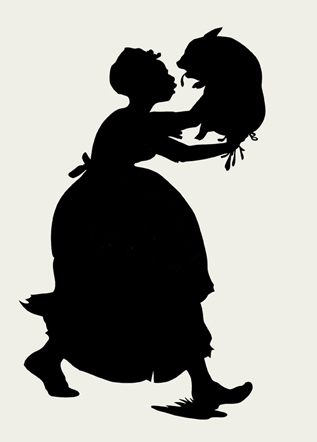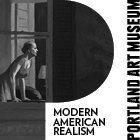
Kota Ezawa, The Simpson Verdict, 2002
digital animation, 3 minute loop
Miller Meigs Collection
Cartoon O.J. Simpson's lips twitch into a brief smile as the word "murder" is spoken for the second time. Cartoon Johnny Cochrane has already embraced his client upon hearing the jury's first verdict: Simpson is found not guilty of his ex-wife Nicole Brown's murder. But O.J. remains frozen until the second verdict--not guilty in the murder of Nicole's friend Ron Goldman--is announced as well. Then he smiles. There is very little activity in Kota Ezawa's 2002 digital animation of the reading of the Simpson verdict, which Ezawa faithfully recreated frame-by-frame from tapes of the trial. O.J. and his lawyers move their heads slightly, the jury stares, Judge Ito moves his arm, the jury stares some more. The few moments of action in the video's recurring loop--O.J.'s smile, the hug from Cochrane, Ron Goldman's mother collapsing into her husband in despair as the verdict is read, Goldman's father's expression of shock--combine to form an oddly harmonious set of motions. Ezawa's three minute video loop creates a colorblocked cartoon of tension, elation, and despair, simplified to the point of absurdity, but mesmerizing.
The Simpson Verdict is one of many powerful works in Habit Forming, curator Joel Leib's second exhibition drawn from the coffers of prominent local collectors. Leib's previous exhibition of this type, The Inside Game, was curated out of the collections of local dealers and focused on emerging artists. It was shown in September 2006 at Portland Art Center.

Kara Walker, The Humane Acquisition of Chitlins, 1994
paper cutout
collection of Marjorie Myers
Most of the work in Habit Forming is stellar stuff by artists we rarely get to see in these parts, and interesting dynamics between pieces abound. Also unusual and refreshing for PDX: a healthy chunk of the art in Habit Forming deals with the African-American experience, including excellent works by Kara Walker and Ellen Gallagher. Walker's The Humane Acquisition of Chitlins faces The Simpson Verdict from across the room, offering a shadowy historical counterpoint to Ezawa's exploration of celebrity justice. A black paper cutout woman, who appears to be a pregnant slave, holds a pig aloft while penetrating it in some mysterious manner. She places the pig's distended tongue close to her face and looks up at it as if preparing for a kiss from a lover or a small child. Walker's use of the word "humane" evokes the ethical failure of slavery while drawing attention to the trickle-down ethical dilemmas of those who must do a master's (or boss's or commander's) bidding.
On the downside, Habit Forming feels overcrowded and the audio from the The Simpson Verdict is distractingly obtrusive in the main room of the exhibition. A few of the works left me cold; a Julian Opie graphic cutout figure of a woman looks like in-store promotional material for an uninspired comic book about relationships. A huge painting of cartoonishly rendered people toiling in a glitter-dusted Boschian hell-scape demands scrutiny without offering much in the way of conceptual or aesthetic rewards. A small Yoshitomo Nara colored pencil sketch seems out of place amid the more finished works.
The smaller of the exhibition's two rooms has a more peaceful vibe. Standout works include Su-Mei Tse's Echo and Paul Pfeiffer's Vitruvian Figure (After Paris Cathedral). In Pfeiffer's photograph, the negative space of the cathedral's floor is subtly created from collaged images of open mouths. I've always admired the minimal beauty of cathedral floor plans and was pleased to see an artist use the form so effectively. Pfeiffer simultaneously references the religious passion of Catholicism and the mathematical genius of Vitruvius, a roman architect who died in 25 BC after developing a system of understanding human proportions that inspired da Vinci, among others. Tse's Echo is beautifully poetic. A tiny figure in a sublime landscape plays a hidden instrument (probably a cello) at the edge of a cliff, while facing a mountain which echoes back, allowing her to create new sounds using herself as accompaniment. The heavily pixelated, saturated and simplified landscape is reminiscent of a video game; the tiny cellist might be the player's avatar. Echo inspires meditation on joys and loneliness of solitary creative activity as well as reflection on humanity's unsymbiotic relationship to the natural world.
Habit Forming includes many more captivating works than the few discussed here, drawn from the collections of Sarah Miller Meigs, Marjorie Myers, Jordan Schnitzer, Erik Schneider, George Stroemple and John C. Jay. The catalogue includes blurbs from each of the collectors, but Meigs seems to speak for everyone when she says, "My collecting reflects my interest in ideas. I never cease to be intrigued and delighted by artists' ideas and their use of materials. It is even more exciting today as there are no restrictions on mediums, anything is possible. Art advances my own understanding of the world and myself." Habit Forming is on view at PNCA's Feldman Gallery through May 30.
I liked the Opie a lot... it along with the Tracey Emin gave that corner a real, best of 90's vibe and rather London-ish one at that. Emin is a lot more influential than she's given credit for, probably because of the tabloid distraction.
I just love how the Ezawa, Emin and Opie work together... a kind of blank "what did you expect" question presented to the viewer. In many ways the Ezawa is kind of a west coast version of Brit-Pop. Walker's work is coming from a completely different place than those othere three.
BTW, it's a free gallery so there's no excuse not to visit.
Good words Jessica.
I stopped in yesterday and saw the show. Sarah Sze's piece reminded me once again why she is one of my favorite artists. Kara Walker, Kota Ezawa and Paul Pfeiffer were the other pieces that really caught my eye. I love that most of the work still felt fresh even with some of the pieces pushing ten plus years old.




















![[TypeKey Profile Page]](http://www.portlandart.net/nav-commenters.gif)